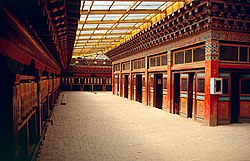Ganden Sumtseling Monastery
| Ganden Sumtsenling Monastery དགའ་ལྡན་སུམ་རྩེན་གླིང་ 松赞林寺 | |
|---|---|
Fifth Dalai Lama 1679 | |
| Two lamaseries – Zhacang and Jikang and Gedong Festival in November |
| Part of a series on |
| Tibetan Buddhism |
|---|
 |
The Ganden Sumtsenling Monastery, also known as Sungtseling and Guihuasi
It belongs to the
Geography
The monastery, with a group of structures packed together on a rolling farm land, located in the town of
Well established road links exist from Shangri-la to Lhasa,
History
The Sumtseling monastery belonging to the Gelukpa order of Buddhism was established by the Fifth Dalai Lama in 1679. It was built during the rule of the
In the 24 April 1936, the monastery had provided full support to the
Structures
The Monastery built in the 17th century as the largest Buddhist monastery in Yunnan province, after a revelation by the
In the main hall of the monastery, more than 1500 monks congregate to recite the Buddhist scriptures. This hall houses a plethora of scriptures written on palm leaves, a gilded statue of
The monastery has two major lamasery buildings – Zhacang and Jikang – apart from several smaller lamaseries. Numerous living rooms have also been built for the monks to reside. The main monastery structure built in Tibetan style has a gilded copper roof similar to the one at the Potala Monastery in Lhasa. The other buildings in the complex are built in Han Chinese style.[7][15]
The road from the old town of the city, leads to the scripture chamber (Gucheng Zangjingtang), which was earlier a Red Army Memorial hall to commemorate the Red Army's long march in the 1930s. At the opposite end of this hall, across the street is the Gulshan Park (Gulshan Gongyuan), which has a monastery with a commanding view of the town and its surroundings. Further along the road, known as the 'Changzeng Lu' (2 kilometres (1.2 mi) long north-south trending street with intersecting roads laid in grid pattern) to the extreme south, is another temple. Passing through this street leads to gardens and a pavilion; and further to the north on a hill, there is a
Festivals
The Gedong Festival is held in the precincts of the monastery annually on 29 November when devotees from the region attend to worship and also to witness the religious mask dances – the Cham dance – that are performed by the monks in colourful costumes depicting deities, ghosts and animals.[16]
A three-day 'Horse Racing Festival' also known as 'Heavenly Steed Festival' is held at Zandiaong, some time in June (according to the lunar calendar: 5th day of the 5th month), to the south east of the town, which involves dancing, singing and eating, in addition to the racing of horses. Horse traders assemble here in their finest attire of furs and silks. Families of villagers camp in tents at the designated horse racing meadow land at an elevation of 3,288 metres (10,787 ft).[17][11]
A new festival introduced in 1990s is called the 'Minority Festival' held in September when artists from neighbouring districts and Tibet participate to present their art forms.[6][11]

Gallery
-
Approach path with steps to the Monastery
-
Butter lamps at the altar of the main temple
-
Decorated corner view of the Monastery
-
Map painted inside monastery
Footnotes
- ^ Osada et al (2000), p. 273.
- ^ ISBN 1-932361-07-3. Retrieved 2010-03-18.
- ISBN 978-0-470-52658-3. Retrieved 2010-03-18.
- ^ "Shangri-La, Ganden Sumtseling Monastery, gilded roof". virtourist.com. Retrieved 2010-03-17.
- ^ a b "Songzanlin Monastery (Shangri-La)". China Travel. Archived from the original on 2010-03-17. Retrieved 2010-03-18.
- ^ ISBN 978-1-84162-169-2. Retrieved 2010-03-17.
- ^ a b c "Shangri-La, Ganden Sumtseling Monastery, gilded roof". virtourist.com. Retrieved 2010-03-17.
- ^ "Shangri-La, old town". virtourist.com. Retrieved 2010-03-17.
- ^ "Shangri-La, Ganden Sumtseling Monastery, gilded roof". virtourist.com. Retrieved 2010-03-17.
- ISBN 978-1-74059-915-3. Retrieved 2010-03-17.
Gandan Sumtseling Monastery.
- ^ ISBN 1-86450-370-X. Retrieved 2010-03-18.
- ^ a b "A Tibetan Monastery in China". Imperial Tours. Archived from the original on 2010-10-06. Retrieved 2010-03-18.
- ^ "Shangri-La, Ganden Sumtseling Monastery". virtourist.com. Retrieved 2010-03-17.
- ^ "Shangri-La, Ganden Sumtseling Monastery". virtourist.com. Retrieved 2010-03-17.
- ^ "Shangri-La, Ganden Sumtseling Monastery, gilded roof". virtourist.com. Retrieved 2010-03-17.
- ^ "Shangri-La, Ganden Sumtseling Monastery, gilded roof". virtourist.com. Retrieved 2010-03-17.
- ISBN 978-1-84162-169-2. Retrieved 2010-03-18.
References
- Osada et al. (2000). Mapping the Tibetan World. Yukiyasu Osada, Gavin Allwright, and Atsushi Kanamaru. Reprint: 2004. Kotan Publishing, Tokyo. ISBN 0-9701716-0-9.









